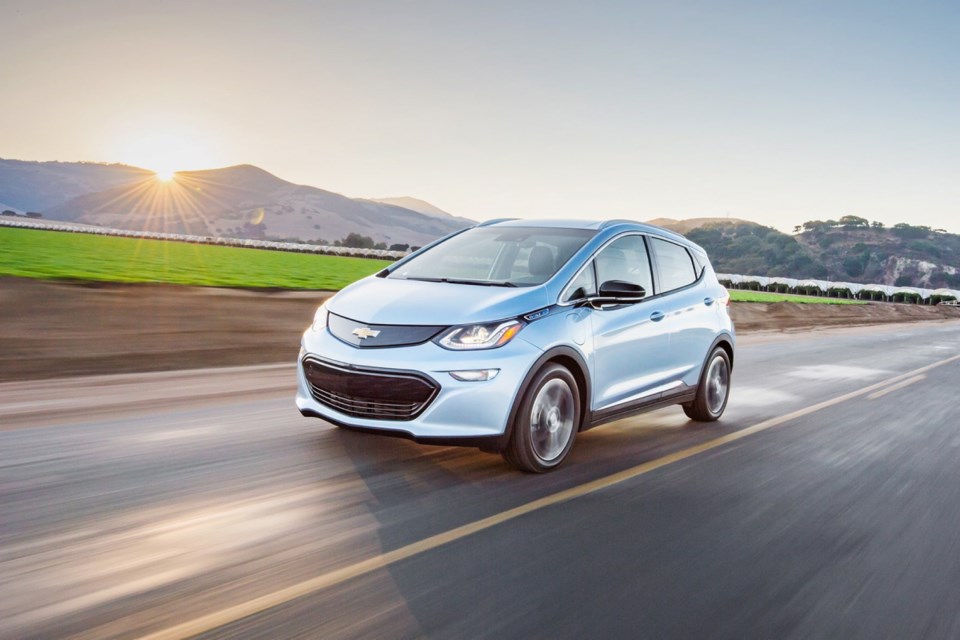To say that the all-electric 2017 Chevrolet Bolt is a game-changer would be an understatement. It might be the breakthrough car that propels the nascent electric-car movement into the mainstream.
Up to now, the biggest hurdle for more widespread acceptance for pure electric vehicles has been their range. “Range anxiety” was a term coined early on as people grappled with worrying about having enough power to make it home.
People used to an internal-combustion car’s range in the hundreds of kilometres on a tank of gas were understandably hesitant to switch to a battery electric vehicle (BEV), which in some cases barely topped 100 kilometres.
There were some brands, such as Tesla, that boasted 300 to 400 kilometres, but they were costly, with some over $100,000.
The Bolt has changed all that. It has a 383-kilometre estimated range at a price starting at $43,195, before incentives.
I drove the Premier trim level, with a $48,095 list price.
After just a few minutes behind the wheel, I had a silly grin from ear to ear as I discovered that this is a fun car.
Chevrolet cheerfully says the Bolt can go from zero to 96 km/h in 6.5 seconds — and I believe it. It hustles from a stoplight compared to the Nissan Leaf and Kia Soul EV. But it is even more impressive on the highway, where it can go from 80 to 120 km/h in 4.5 seconds, which is about twice as fast as the Leaf.
I would like to think that the Bolt is really a sports car masquerading as a green machine.
A look under the hood reveals an electric motor that produces 200 horsepower and 266 foot-pounds of torque. That’s a serious amount of power.
If you could peek under the floor, you would find 60 kWh lithium-ion batteries, again double that of the Leaf.
To allay the fears of range anxiety, the Bolt gives drivers three range numbers to chew on — maximum, minimum and a best-estimate number based on your individual driving style and ambient conditions.
The Bolt has a 7.2-kWh onboard charger (the higher the number, the more quickly it can charge). The battery can be charged with a household 120V charger, with a dedicated Level II 240V charger and an optional 400V DC fast charger that can deliver 145 kilometres of range in 30 minutes.
That last feature, not available in the Leaf or Soul, is where engineers think the market will grow. Although there are fewer fast chargers than Level II chargers across the country, that is perhaps the best viable option to travelling across the country unplugged in the future.
While the Bolt might have solved how to get across the country, or to get you to work and back, it doesn’t stop there.
The interior of the Bolt is equally impressive.
It has a fairly tall seating position (remember the batteries are stowed below), so the Bolt feels more like driving a small crossover in that you have a better view around you.
The interior is well-organized, with a centre console that swallows mugs, phones and even purses easily. The backs of the front seats are moulded to maximize rear legroom, making for a more generous space for adults in the back.
My tester was the Premier trim, with a number of desirable features. The jewel in the crown is a state-of-the-art rearview camera/mirror that takes up the whole mirror, not just a portion of it as in some of the competition. Other features include a 360-degree camera system, parking sensors and blind-spot monitoring.
The optional Driver Confidence package includes front pedestrian braking, collision alert, lane-keep assist and low-speed forward automatic braking.
The infotainment system includes a Bose audio system, wireless charging for phones and USB charging ports for rear passengers.
The driver gets a 20.3-centimetre customizable driver information screen instead of analog instruments clustered directly in front. The infotainment system is housed in a separate 25.9-cm screen at the top of the centre console.
On the energy screen, occupants can get real-time updates on energy used, energy remaining and climate control. They also get feedback on how a driver has driven, in eight-kilometre intervals over the previous 80 kilometres. The car even rates energy consumption based on driver on technique, terrain and outside variables.
No navigation system is offered. The expectation is that you will integrate your smart phone to use Android Auto or Apple CarPlay to find your way to your destination.
If you enjoy navigating a cellphone or tablet, you will take to the Bolt’s interface like a fish to water.
The 2017 Chevrolet Bolt is a game-changer in the electric-vehicle market. This is a car that makes the competition improve their game in order to keep up. I don’t envy the engineers of rival firms being shown a Bolt and tasked to bring their offerings up to the new performance bar.
Tesla hasn’t been idle, with their Model 3 set to challenge the Bolt perhaps next year. The company has claimed more than 500,000 people have already put down a deposit on the new car.
Until then, the Bolt is the one to beat — in price, range and innovation.



